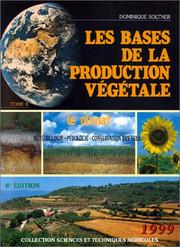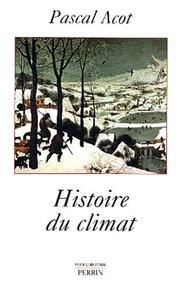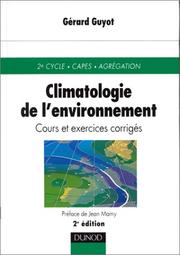| Listing 1 - 10 of 12 | << page >> |
Sort by
|
Book
ISBN: 9782100704583 2100704583 Year: 2013 Publisher: Paris: Dunod,
Abstract | Keywords | Export | Availability | Bookmark
 Loading...
Loading...Choose an application
- Reference Manager
- EndNote
- RefWorks (Direct export to RefWorks)
Bioclimatologie --- Problèmes et exercices. --- Végétation et climat --- Agrométéorologie --- Bilan énergétique (Géophysique) --- Météorologie --- Climatologie --- Instruments --- Météorologie - Instruments
Book
ISBN: 0387061061 3540061061 0412684209 364265522X 3642655203 9783540061069 Year: 1973 Volume: 7 Publisher: Berlin: Springer,
Abstract | Keywords | Export | Availability | Bookmark
 Loading...
Loading...Choose an application
- Reference Manager
- EndNote
- RefWorks (Direct export to RefWorks)
Climate --- Bioclimatology --- Mediterranean climate --- Bioclimatologie --- Climat méditerranéen --- Bioclimatology. --- Mediterranean climate. --- Geografie --- Landschapskunde --- Ecologie. --- Biogeography --- General ecology and biosociology --- Mediterranean countries --- Climat méditerranéen
Periodical
ISSN: 00207128 Publisher: Amsterdam:
Abstract | Keywords | Export | Availability | Bookmark
 Loading...
Loading...Choose an application
- Reference Manager
- EndNote
- RefWorks (Direct export to RefWorks)
Biology --- Bioclimatology --- Bioclimatologie --- Periodicals. --- Périodiques --- Agriculture Sciences --- Soil Chemistry, Microbiology, Fertility & Fertilizers --- Meteorology --- Pollution (Air, Noise, Soil and Water) & Control --- Evolutionary Studies --- Zoology --- Earth Sciences --- Environmental Sciences --- Life Sciences --- Agriculture Sciences. --- Zoology. --- Earth Sciences. --- Environmental Sciences. --- Life Sciences. --- Bioclimatologie. (Revue) --- Bioklimatologie. (Tijdschrift)

ISBN: 290771001X 9782907710015 Year: 1999 Publisher: Sainte-Gemmes-Sur-Loire: Sciences et techniques agricoles,
Abstract | Keywords | Export | Availability | Bookmark
 Loading...
Loading...Choose an application
- Reference Manager
- EndNote
- RefWorks (Direct export to RefWorks)
Techniques agricoles --- Climatologie --- Bioclimatologie --- Agrométéorologie --- Pédologie --- Plantes --- Cultures et sols --- Effets du climat --- Soil --- Érosion --- Erosion --- soil fertility --- Plant production --- climatic factors --- Plant response --- Erosion. --- Techniques agricoles. --- Climatologie. --- Bioclimatologie. --- Agrométéorologie. --- Pédologie. --- Cultures et sols. --- Effets du climat. --- Plant production. --- Cereals. --- Prairies. --- Cultivation. --- maize. --- Potatoes. --- extension activities. --- Betterave --- France.
Book
ISBN: 9782757838242 2757838245 Year: 2014 Volume: 214 Publisher: Paris: Seuil,
Abstract | Keywords | Export | Availability | Bookmark
 Loading...
Loading...Choose an application
- Reference Manager
- EndNote
- RefWorks (Direct export to RefWorks)
Notre planète est multiple, et les tropiques n'ont que peu à voir avec les zones tempérées que nous habitons. La richesse et l'étrangeté de la faune et de la flore dans la zone intertropicale, les particularités de ses climats et de ses paysages en font véritablement un autre monde. Mais les spécificités des tropiques sont également celles des hommes qui y vivent et de leurs sociétés, si différentes des nôtres par leur évolution. Aussi Francis Hallé propose-t-il une très audacieuse hypothèse, liant astronomie et biologie humaine, quant aux raisons de ces particularités, hypothèse qui pourrait bien déboucher sur une sérieuse révision des stratégies de développement des zones tropicales.
Ecology --- Bioclimatology --- Human geography --- Ecologie --- Bioclimatologie --- Géographie humaine --- Tropics --- Régions tropicales --- Geography --- Social conditions --- Géographie --- Conditions sociales --- -Natural history --- -Human ecology --- Géographie humaine --- Régions tropicales --- Géographie --- Bioclimatology - - Tropics --- Natural history - - Tropics --- Human ecology - Tropics

ISBN: 9782262019037 2262019037 Year: 2003 Publisher: Paris: Perrin,
Abstract | Keywords | Export | Availability | Bookmark
 Loading...
Loading...Choose an application
- Reference Manager
- EndNote
- RefWorks (Direct export to RefWorks)
Le climat écrit-il notre histoire ? En s'appuyant sur des données scientifiques et historiques, Pascal Acot reconstruit la longue histoire du climat et montre qu'elle est indissociable de celle des êtres humains. Cette remontée dans le temps éclaire bien des controverses historiques, comme le déclin de l'Empire romain, le désastre de la bataille de Crécy, les famines à l'époque médiévale, le déclenchement de la Fronde, ou encore, en Russie, les défaites militaires attribuées au général Hiver. Pascal Acot encourage néanmoins à la plus grande prudence : rien ne permet de dire que la Révolution française est due au petit âge glaciaire, même si celui-ci a joué un rôle majeur dans l'histoire économique et sociale de la France moderne. L'humanité est toujours parvenue à s'émanciper de son environnement : la brillante culture magdalénienne ne s'est-elle pas épanouie au cœur d'une glaciation ? Cependant il est un fait nouveau, une véritable révolution à l'échelle de l'histoire : jamais avant l'ère industrielle, l'homme n'avait pu influer sur le climat. Or les scientifiques affirment désormais que le réchauffement de la planète lié aux activités humaines aggrave les dérèglements actuels. Ces découvertes exercent aujourd'hui une grande fascination mais suscitent aussi de nouvelles peurs. Cette histoire donne au lecteur les clefs pour comprendre les enjeux du monde à venir et invite à une réflexion politique sur le destin de la planète.
Human beings - Effect of climate on --- Climate - History --- Climatology --- Homme --- Bioclimatologie. --- Changements climatiques. --- Réchauffement de la Terre --- Climatologie --- History. --- Effets du climat. --- Climatology. --- Réchauffement de la Terre. --- Climatologie. --- Human beings --- Climate

ISBN: 2100044419 9782100044412 Year: 2008 Publisher: Paris: Dunod,
Abstract | Keywords | Export | Availability | Bookmark
 Loading...
Loading...Choose an application
- Reference Manager
- EndNote
- RefWorks (Direct export to RefWorks)
Végétation et climat --- Agrométéorologie --- Bioclimatologie --- Bilan énergétique (Géophysique) --- Météorologie --- Climatologie --- Instruments --- Agroclimatologie --- Vegetation et climat --- Agrometeorologie --- Bilan energetique (Geophysique) --- Végétation et climat --- Meteorologie --- Météorologie - Instruments --- Meteorologie - Instruments --- TEACHING MATERIALS --- BIOCLIMATOLOGY --- ELECTROMAGNETIC RADIATION --- TURBULENCE --- WATER FLOW --- EVAPOTRANSPIRATION --- PRECIPITATION --- ATMOSPHERE --- ENVIRONMENTAL FACTORS --- HEAT FLOW --- MASS FLOW --- GREENHOUSE EFFECT --- MICROCLIMATE --- CLIMATOLOGY --- AGROCLIMATOLOGY --- CLIMATE --- CLIMATIC FACTORS --- HUMIDITY --- STATISTICAL ANALYSIS --- MEASUREMENT
Book
ISBN: 9782311000269 2311000268 Year: 2010 Publisher: Paris: Vuibert, AFAS,
Abstract | Keywords | Export | Availability | Bookmark
 Loading...
Loading...Choose an application
- Reference Manager
- EndNote
- RefWorks (Direct export to RefWorks)
Etude des conséquences du changement climatique sur le monde du vivant et la biodiversité. Des exemples concrets pris dans différents milieux, temps et régions, sont proposés pour illustrer le propos, suivis d'un aperçu sur le difficile problème de la modélisation des réactions du monde du vivant aux changements climatiques.
Climatic changes --- Biodiversity --- Global temperature changes --- Environmental aspects --- Climatic factors --- Climatic changes. --- Biodiversity. --- Bioclimatology. --- Paleoclimatology. --- climat --- Diversité végétale. --- Diversité des espèces. --- Climat --- Biodiversité --- Température atmosphérique --- Biodiversité. --- Bioclimatologie. --- Paléoclimatologie. --- biodiversité --- évolution. --- Changements --- Aspect de l'environnement --- Facteurs climatiques --- Modification à l'échelle planétaire --- Changements. --- modification --- modification.
Book
ISBN: 2225855145 9782225855146 Year: 1997 Volume: *1 Publisher: Paris: Masson,
Abstract | Keywords | Export | Availability | Bookmark
 Loading...
Loading...Choose an application
- Reference Manager
- EndNote
- RefWorks (Direct export to RefWorks)
Climate (Uf) --- Climatologie --- Climatology --- Klimatologie --- Plant biometeorology --- Vegetatie en klimaat --- Vegetation and climate --- Végétation et climat --- Végétation et climat. --- Agroclimatologie. --- Climatologie. --- Bioclimatologie. --- water --- Écosystème --- ecosystems --- Couverture végétale --- Plant cover --- Physiologie végétale --- Plant physiology --- Énergie solaire --- Solar energy --- Atmosphère --- Atmosphere --- Échange thermique --- Heat transfer --- Changement climatique --- Climatic change --- Observation météorologique --- meteorological observations --- Mesure --- Measurement --- Végétation et climat. --- Biotic communities --- Climatic factors --- Atmosphere. --- Relation plante atmosphere
Book
ISBN: 9780415842143 041584214X 9780415842150 0415842158 9781315661384 9781315661384 1315661381 9781317339939 1317339932 9781317339953 1317339959 9781317339946 1317339940 Year: 2020 Publisher: New York : Routledge,
Abstract | Keywords | Export | Availability | Bookmark
 Loading...
Loading...Choose an application
- Reference Manager
- EndNote
- RefWorks (Direct export to RefWorks)
"Visually enriched with over 250 photographs and drawings, Bioclimatic Double-Skin Façades is an essential reference guide for understanding the types and functions of double-skin facades. Author Mary Ben Bonham examines the history and continuing potential of double-skin architecture, informing on the variety of approaches possible and advising a rigorous integrated design process leading to application. Featuring a wide selection of architectural examples, the book will be of interest to professionals and students within the fields of architecture, engineering, and construction. Characterized by a buffer-like air space between two glazed building skins, double-skin windows and facades aim to improve building comfort and energy performance. Double skins introduce complexity and initial costs, yet significant buildings in locations around the globe continue to select this approach. In addition to exploring motivations, benefits, and cautions for designing with double skins, the book provides a primer on fundamental facade design concepts and strategies for control of thermal, luminous, and acoustic environments. Chapters also address alternative types of high-performance facades and implications for each phase of facade design and construction. Bioclimatic Double-Skin Facades promotes bioclimatic design that is inspired by nature, measured in performance, and uniquely adapted to climate and place. In-depth case studies illustrate how double-skin facades have been adapted to a range of climates and cultural settings: Marseille Library and Grenoble Courthouse in France, Cambridge Public Library in Massachusetts, Manitoba Hydro Place in Canada, and the Pearl River Tower in China"--
Exterior insulation and finish systems --- Facades --- Bioclimatology --- Bioclimatics --- Biometeorology --- Climatology --- Ecology --- Architectural fronts --- Fronts (Architecture) --- Architecture --- Exterior walls --- EIFS (Building materials) --- Synthetic stucco --- Insulation (Heat) --- Stucco --- Design and construction --- Details --- 692.23 --- Architectuur ; gevels ; façades --- Architectuur ; bio-klimatisch geregelde --- Thermische isolatie; gordijngevels --- Constructie-elementen van gebouwen ; buitenmuren, gevels --- Exterior insulation and finish systems. --- Isolation thermique --- Façades --- Bioclimatology. --- Bioclimatologie --- Design and construction. --- Conception et construction. --- 69 --- 692.2 --- Bouwtechniek --- Gevels --- Facades - Design and construction --- Façades
| Listing 1 - 10 of 12 | << page >> |
Sort by
|

 Search
Search Feedback
Feedback About UniCat
About UniCat  Help
Help News
News